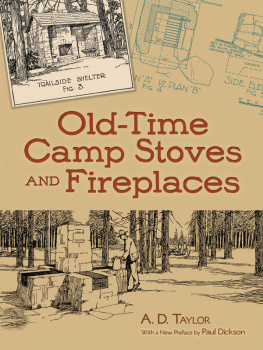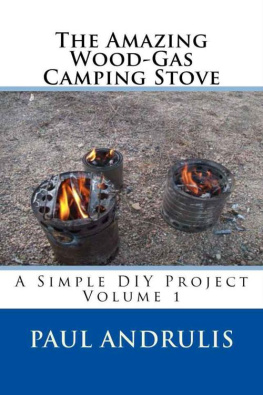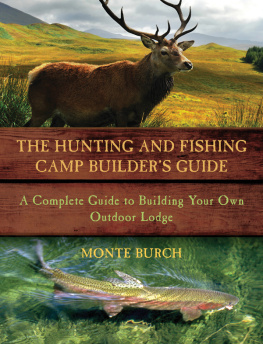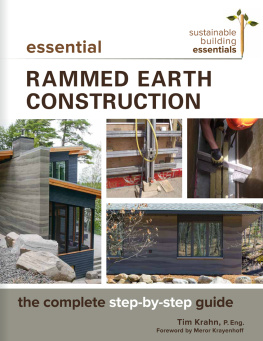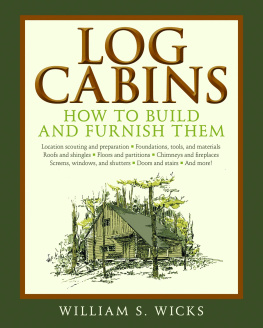Old-Time Camp Stoves AND Fireplaces
A. D. Taylor
With a New Preface by
Paul Dickson
Dover Publications, Inc.
Mineola, New York
Copyright
Preface to the Dover Edition copyright 2012 by Paul Dickson.
All rights reserved.
Bibliographical Note
This Dover edition, first published in 2012, is an unabridged republication of Camp Stoves and Fireplaces as prepared by The Forest Service of the United States Department of Agriculture, and originally published by the US Government Printing Office, Washington DC, in 1937.
International Standard Book Number
ISBN-13: 978-0-486-49020-5
ISBN-10: 0-486-49020-3
Manufactured in the United States by Courier Corporation
49020301
www.doverpublications.com
PREFACE TO THE DOVER EDITION
THIS delightfully illustrated primer on constructing outdoor stone fireplaces, barbecue pits, camp stoves, and campfire circles was originally published in 1937 for the Civilian Conservation Corps, or CCC, by the United States Forest Service.
The CCC was a New Deal program that operated from 1933 to 1942, providing work for unemployed, unmarried men, ages 17-23. Besides providing employment during the Great Depression, the goal of the program was to conserve and protect natural resources. By the time the program was discontinued, this Corps of young men had planted nearly 3 billion trees, constructed more than 800 parks, and upgraded most of the existing state parks. They built trails and roads in remote areas of the country and created golf courses and softball fields closer to urban areas.
The designs in this book are those which the CCC used to create these outdoor amenities in parks and along trails from coast to coast. Often created from rock found at or near the construction site, they were built for heavy use and long-term durability.
When I discovered the original version of this publication at a used book sale, I had an immediate sense of nostalgia when I realized that the high chimney stove on page 53 () is not unlike the one my father built in our backyard during the late 1940s. Other outdoor fireplaces in the book look like those that, while growing up, I often saw in parks at all levelslocal, state and national. Come to think of it, so did my kids, because a large percentage of these CCC fireplaces or those based on their design were still standing while they grew up, and many are still standing today. According to a news report in 2011, custodians of one state park in West Virginia started a program to restore 20 original CCC fireplaces. The condition ranged from those that had been completely leveled to those whose condition was considered not that bad.
The stoves and fireplaces in this book are timeless classics, and have a certain appeal in this age of expensive, propane-fueled stainless steel barbecue grillsand part of this appeal is that they were built to last a few generations rather than a few grilling seasons.
PAUL DICKSON
FOREWORD
THE national forests with their lakes, streams, mountain ranges, and mountain peaks, including an area more than five times as large as all New England, contain a large part of the natural outdoor recreational areas in the United States.
The Forest Service of the United States Department of Agriculture, charged with the custodianship of the national forests, considers these recreational possibilities as public resources, to be wisely used and carefully safeguarded. Because of the public demand for use of these recreational areas, the Forest Service, within the limits of the funds available and consistent with the primary purposes for which the national forests have been created, is doing everything possible to properly and adequately develop these recreational resources for public use.
The Civilian Conservation Corps, during the last 3 years, has made it possible to carry on an extensive program of work in the development of these recreational areas which otherwise would have been impossible or long delayed.
In order to protect the forests from fire, to provide sanitary safeguards, and to furnish suitable public conveniences, it has been necessary to designate thousands of campgrounds and picnic areas and to provide these areas with simple and adequate improvements.
On the great majority of campgrounds and picnic areas fires are essential for cooking, for campfires, and for warming fires. To fully protect the forest growth, on and surrounding these recreational areas, it is necessary that these fires be confined within camp stoves, fireplaces and campfire circles. The importance of appropriate design for these features has prompted the Forest Service to make a careful and extensive study of this subject in order to determine the types of camp stoves and fireplaces best adapted to use under varying conditions.
This subject is of growing significance because of the increasing importance of recreational activities not only in the national forests; but on all recreational areas throughout the United States in connection with which these facilities are essential.
Mr. A. D. Taylor, consulting landscape architect for the Forest Service, made a careful study of this problem during the summer and fall of 1935. He has condensed his findings into the following pages. As the author states, it is fully appreciated that this presentation of the subject cannot be considered as complete. The text and drawings represent an effort at this time to make available in clear and definite form, the most authoritative information compiled to date on the subject of camp stoves and fireplaces.
It is my hope that this publication will be of real value to forest officers and to the thousands of others responsible for the planning and construction of recreational improvements throughout the United States.
June 5, 1936.

Chief, Forest Service.
PREFACE
THE tendency for an increasing number of people to procure relief from the physical and mental strain of earning a living, by seeking the atmosphere of nature in the national forests, parks, and in thousands of other similar areas, creates an important problem for those who are concerned in meeting the needs of recreation. The problem of providing campground and picnic-area facilities, especially camp stoves and fireplaces, is increasing proportionately. The importance of this problem is further emphasized by the fact that during the summer of 1935 the throng of campers and picnickers using only the national forests had increased to 8,000,000.
Because of the influx of people, especially into the national forests, the national parks, and the State and metropolitan parks, the use of the areas adapted especially for camping and picnicking would be impractical if facilities for cooking fires and for warming fires could not be confined to camp stoves and fireplaces, for the following reasons:
A. To reduce to a minimum, on wooded areas, the ever-present fire hazard.
B. To increase the convenience and the comfort of mans use of these forest areas.
C. To protect vegetation against unnecessary destruction.
The great majority of those who are seeking recreation in the forests not only desire, but require these facilities for their convenience and comfort. There is a small minority, however, who are strongly prejudiced against the introduction of any man-made facilities into the forests. These individuals have an innate love of nature in the raw, and they fortunately are able to adjust themselves to the conditions of nature without the aid of these facilities which are normally a part of any important campground and picnic area. Those recreation areas which are provided with facilities to increase the comfort and convenience of the people who cannot readily adapt themselves to nature in the raw, are the most popular. In the development of any of these features, it is not practical or necessary to attempt to provide the conveniences which one can have at home. It is necessary, however, to avoid too great inconvenience in the use of these facilities in order that those who are less hardy may reap the full enjoyment from their short stay rather than to expend their energy in adapting themselves to conditions to which they have not become accustomed.
Next page
